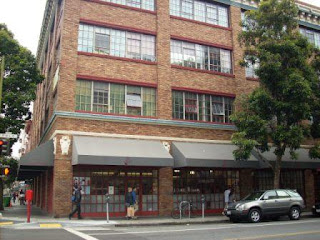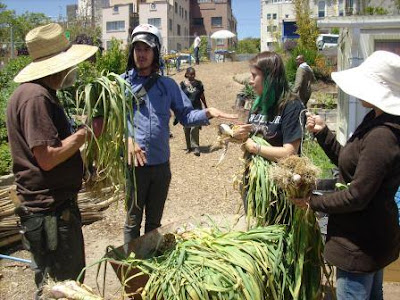Most tour participants were SF residents, including several from the Tenderloin. It was a lively and interactive tour (one resident passing by told us “no photographs, no autographs”). As Peter worked in the Tenderloin as a psychiatric social worker, he shared his insights. During the 1970s urban renewal, the destruction of SROs in Western Addition and SoMa drove the poor to the Tenderloin, which has the world’s largest collection of historic SRO hotels and the largest concentration of homeless in the City. Here are some tour highlights:
We began at McAllister and Leavenworth Streets, facing the former William Taylor Hotel, which was built by Methodists as a church on the ground floor within a hotel (sounds similar to plan to rebuild Saint Paulus Church within housing tower at The Free Farm site). Shortly after its 1929 opening, the hotel suffered due to the Great Depression, so it was sold and remodeled as the Empire Hotel, SF’s tallest building at the time. A local law prevented building a saloon within 200 feet of a church, so the Sky Room lounge was built on the top floor. During WWII, the federal government used its eminent domain powers to acquire the hotel, which was converted to a federal building housing the IRS and draft board. In the late 1970s, the site was sold to UC Hastings College of Law, which converted it into student housing.
(My background includes living in the Tenderloin for a summer, while I worked at now-defunct SF Redevelopment Agency (SFRA) in Western Addition and shared an apartment with a classmate at McAllister Tower (http://www.uchastings.edu/housing/). Like JFK said about working in the White House, the pay was good and I could walk to work :-). I worked at SFRA for two years: part-time during school and full-time during one summer break. SFRA’s use of eminent domain displaced many years before so I joined my supervising attorney to volunteer with Homeless Advocacy Project (http://www.sfbar.org/volunteer/homeless_article.aspx), which held a weekly clinic at Cadillac Hotel (http://www.cadillachotel.org/), the first non-profit SRO west of Mississippi.)
Tenderloin Housing Clinic (http://www.thclinic.org/) Executive Director Randy Shaw is working to create Uptown Tenderloin Museum (http://uptowntl.org/museum.php) inside Cadillac Hotel (http://www.foundsf.org/index.php?title=The_Cadillac_Hotel_Shaped_History_of_San_Francisco). The hotel also was home to Newman’s Boxing Gym, where George Foreman and Cassius Clay (before name change to Muhammad Ali) trained.
These banners remind us that Tenderloin is in the Heart of the City, with 409 historic buildings.
Streetopia (http://streetopiasf.com/) is a month-long show, run out of Luggage Store Annex (http://www.luggagestoregallery.org/) at 509 Ellis Street near Leavenworth, that expresses utopian aspirations including a Free Café, theater, gallery/studio, library, public murals, art on area billboards, installations in vacant storefronts, performances in the streets, and events at nearby community gardens. (See Public Service Announcement listing below.)
Next door to Luggage Store Annex, Cohen Alley was transformed into Tenderloin National Forest (http://www.luggagestoregallery.org/tnf/) with real and painted trees.
Love lung power!
This Faithful Fools building was a former film exchange building. (At annual Meat Out, sponsored by SFVS and Unitarian Center in Western Addition, I volunteer with Chef Andrea of Faithful Fools (http://www.faithfulfools.org/) to prepare vegan lunch.)
Tenderloin’s entertainment included jazz (like Blackhawk), as well as theater and porn.
Food secure pigeons well-fed by residents
Peter holds up photo of 19th century old grocery saloon at Turk and Polk Streets, with side door entrance for single women. At the time, two-thirds of saloons were located in the back of grocery storefronts.
Das Deutsches Haus, aka California Hall, 625 Polk Street, is significant for its role in LGBT history (http://www.foundsf.org/index.php?title=San_Francisco_Police_Hold_a_Scandalous_Orgy).
From 1921 to 1925, Dashiell Hammett lived at 620 Eddy, in a two-room studio above his landlady bootlegger; seems 1920s Prohibition was as effective as today’s War on Drugs? Peter noted how prohibitions drive vices underground. He mentioned that some landlords prefer tenants involved in illegal activities so they can extort higher rents, so vice and corruption persist. (After tour, I was curious about rents at Hammett’s old building so I internet-searched the address and found studio #44 went for $1,250 in April 2012.)
Eye-catching mural
Entrance to Little Saigon, which brought many families into neighborhood and my favorite banh mi!
Not included in tour, but I volunteer at Project Open Hand, 730 Polk Street, so check out http://www.openhand.org/join-us/volunteer/. I remember this location was Sierra Club HQ before POH.
With a gap after the tour until afternoon Streetopia event, I headed over to Asian Art Museum for Phantoms of Asia exhibit about our place in the universe. This striking painting, "Dohatsu Shoten," by Hyon Gyon, reminded me of Edvard Munch’s "The Scream"; the plaque explained that it represents “anger that makes one’s hair stand on the end and even reach the sky”—an emotion that we feel but usually hold inside. Pretty intense, so time to step outside . .
I love looking up at the old Main Library’s engravings, like this Longfellow saying: “Nature is a revelation of God, art is a revelation of man.”
Back into the Forest sanctuary
Lisaruth sets up her Lovin’ from the Oven no knead bread making demo station with basics: flour, salt, yeast, warm water. Lisaruth’s utopian agenda is that “we slowly begin to understand ourselves more as bread MAKERS than bread WINNERS.”
Beekeeper Pam donated The Free Farm's Hecka Local Honey to accompany Lisaruth’s Seeding is Believing Bread. Honey + Bread combination is delicious!
Lisaruth’s Mobile Bread Bicycle Cart, almost like meals on wheels! Cob oven is heated to 450F to bake bread.
Sy Wagon presents The Free Cafe, which will take place daily, noon to 4 pm, at 509 Ellis Street and Tenderloin National Forest during the length of Streetopia’s run (May 21 to June 23). The cafe will provide a community kitchen for neighborhood residents to come together and share food and recipes. The cafe is looking for donations of produce. Contact sywagon@gmail.com (http://streetopiasf.com/2012/04/09/the-free-cafe-is-looking-for-recipes-volunteers-and-food/)
Free Café offerings include sautéed kale and onions, grated beets and peppers, waffles, butter, whipped cream, maple syrup, coffee and milk.
Returned to Asian Art Museum for armchair talk on Traditional Chinese Medicine. “Breathing flower” by Choi Jeong Hwa, sits outside.
More about Tenderloin's rich history and culture at http://en.wikipedia.org/wiki/Tenderloin,_San_Francisco,_California. In addition to BeyondChron (http://www.beyondchron.org/), Tenderloin has a wonderful monthly community newspaper, Central City Extra, which featured May 2012 cover story, “Free Food for Sale” (http://www.studycenter.org/test/cce/index.html) and April 2012 article, “Farmers’ markets give away a ton of food” (http://www.studycenter.org/test/cce/issues/121/ccx.121-cp4.pdf).
Peter will present his fascinating Tenderloin walks again in October 2012 through http://www.sfcityguides.org/desc.html?tour=79 & http://www.sfcityguides.org/desc.html?tour=80. In the meantime, SF City Guides has two upcoming walks covering The Free Farm’s Western Addition neighborhood (see Public Service Announcements listing below for May 31 and June 2; http://en.wikipedia.org/wiki/Western_Addition,_San_Francisco,_California).
And check out Streetopia's events, which focus on community empowerment!
Public Service Announcements:
Thurs., May 31, 2012, 1 pm Sacred Places in SF Cathedral Hill
Meet at the main plaza entrance of St. Mary's Cathedral, Gough & Geary, SF
SF’s diversity is reflected in its places of worship. Visit churches, a temple, a cathedral and a synagogue. View the symbols and architecture and hear the history of the city’s religious institutions. http://www.sfcityguides.org/desc.html?tour=70
Sat., June 2, 2012, 2 pm Japantown, Urban Renewal & the Fillmore
Meet at the Japantown Peace Pagoda at Buchanan between Post & Geary, SF
SF’s Japantown dates from the earthquake and fire of 1906. Later, Japanese-Americans were uprooted in WWII and replaced largely by African-Americans who opened many jazz clubs. Then, in the 1950s, urban renewal changed the physical landscape. Today we see Japanese-style architecture next to classic Victorians and the birth of the Fillmore Jazz Preservation District. http://www.sfcityguides.org/desc.html?tour=45
Sun., June 3, 2012, 1 pm Every Block has a Story: The People’s History of the Central City
Meet at Luggage Store Gallery, 1007 Market St., near 6th St., SF 94103
Join Tenant Organizer James Tracey and Tenderloin native Lisa Cleis for walking tour and organizing. http://streetopiasf.com/Streetopia_calendar.pdf




































































